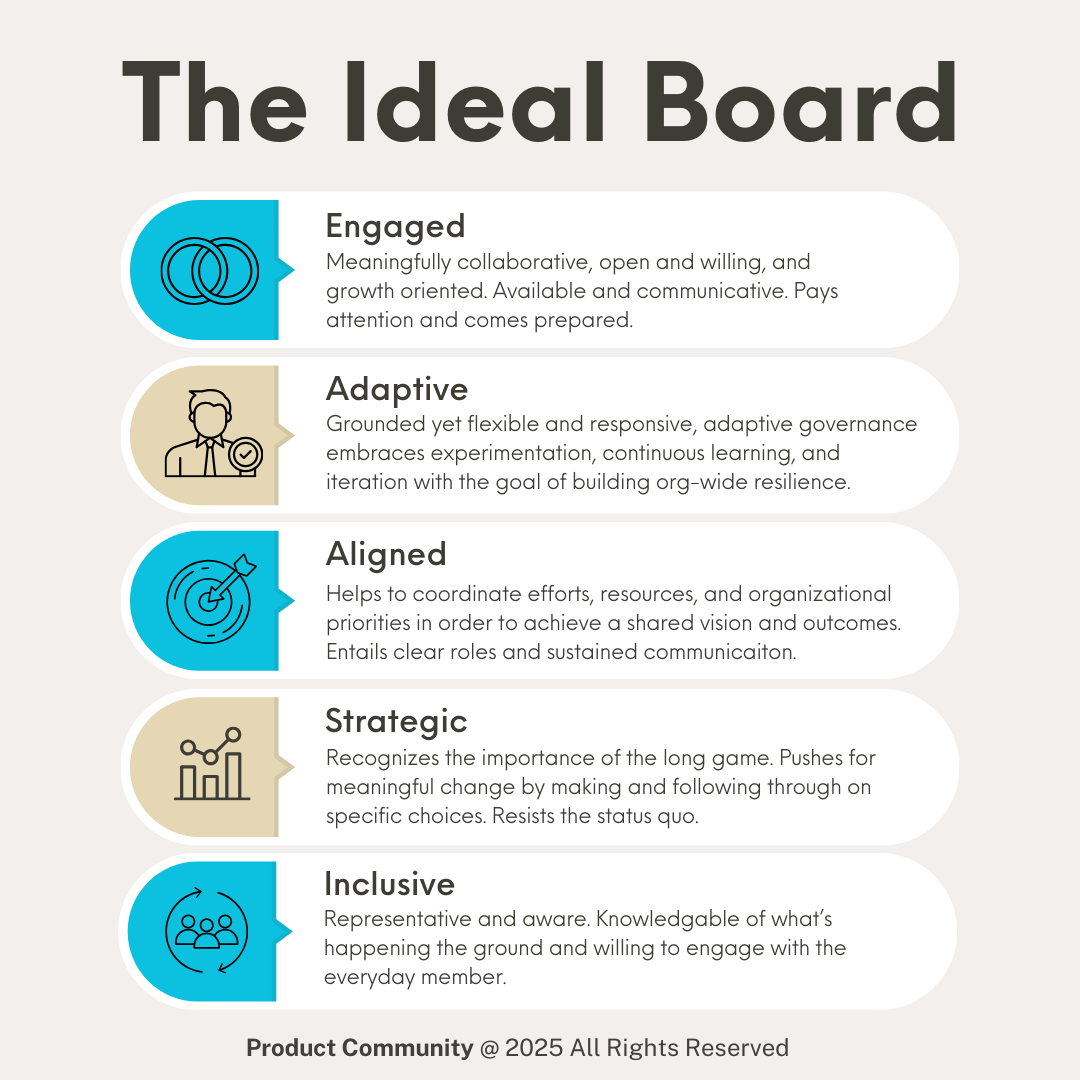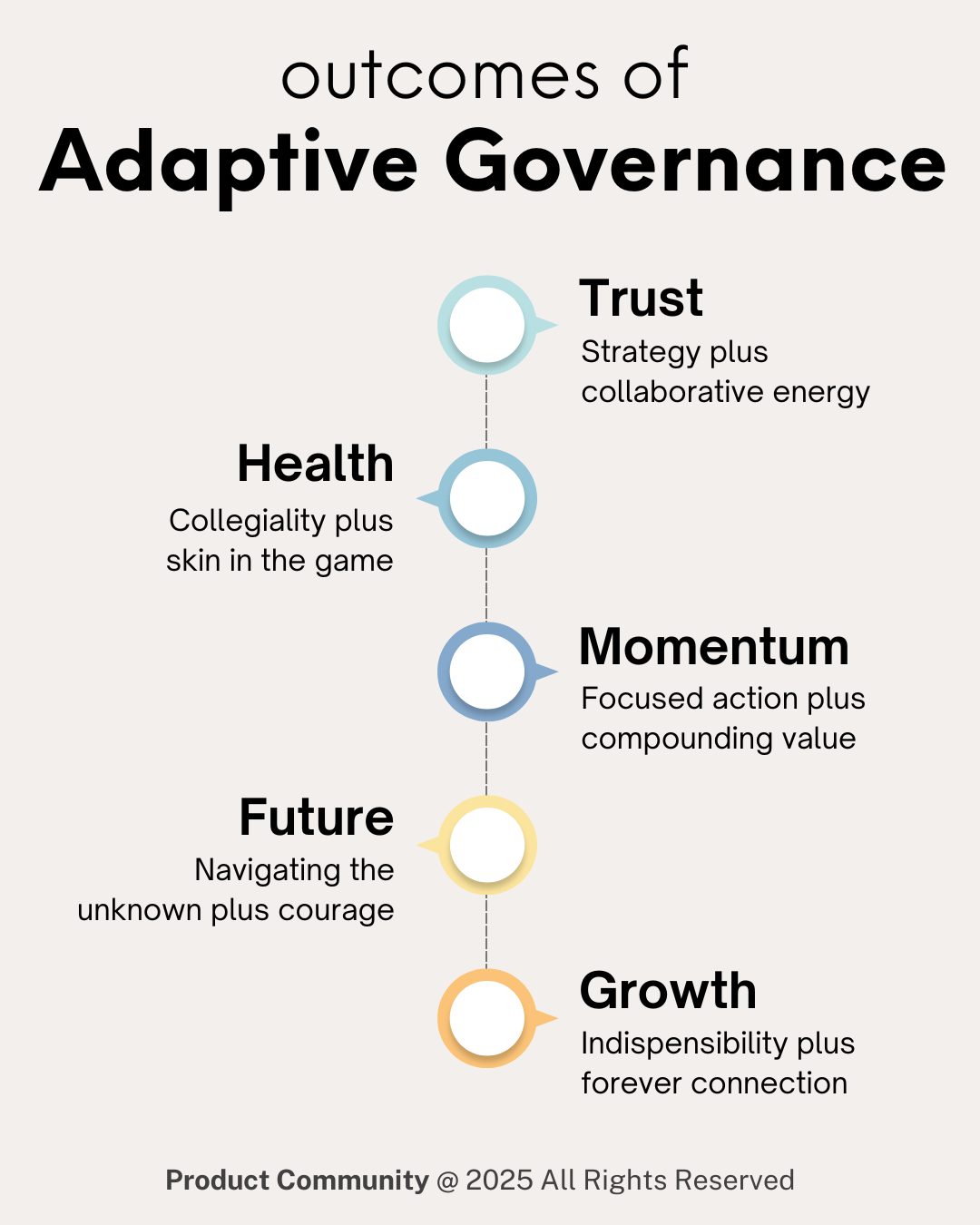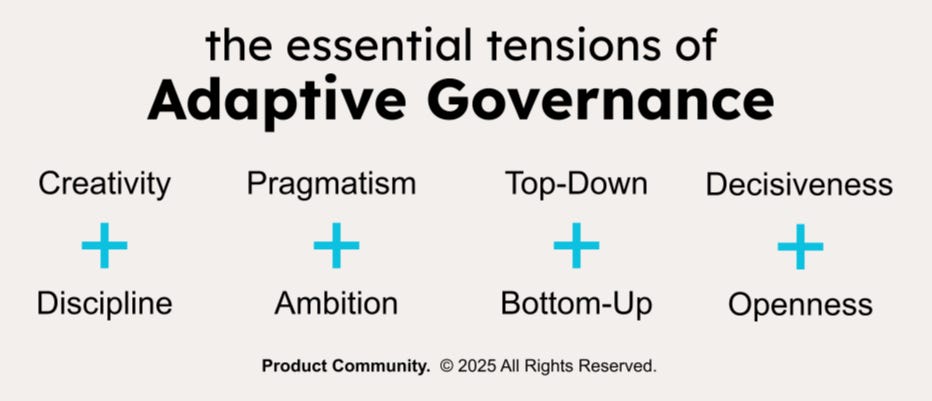The Ideal Board
Adaptive Governance and the Mandate to Innovate
Summary
In a world afire with change, traditional governance is no longer sufficient. A shift toward adaptive boards grounded in responsiveness will help us navigate uncertainty. Even more, it will help us innovate.
I write about associations, innovation, and community. Fairly early in my career, I reported to the president of a start-up university. He was a longtime higher-ed leader who had become cynically blunt. “Treat ‘em like mushrooms!” he’d say of our board, “keep ‘em in the dark and feed ‘em a bunch of shit!”
This is an article about cultivating and creating an ideal board that helps shift an association from a garden variety service provider into a powerful value engine. This isn’t just a clever turn of phrase, it’s how we can meet the new needs of our members in an increasingly complex and unpredictable world.
I lead the product community®, a product development learning community designed specifically for associations. Let’s compare ideas and build something great.
Why We Need Great Boards
“The more you give, the more you’ll receive – whether that’s advice, opportunities, or lasting partnerships. Build relationships based on genuine support, not just transactions.”
Marc Benioff
Descriptions of what makes a good board are everywhere, yet over and over we find standard disconnects: politics outweigh balance, angling outweighs goodwill, ambition outweighs action, partial attention feeds overreach, pet projects outweigh the common good, tactics outweigh true strategy.
Here is a list of the common reasons why we need good boards. This is a baseline of competence, not a high bar of excellence.
Governance and Oversight Boards provide crucial oversight of management, ensuring leaders are making decisions in the best interests of the organization and its stakeholders.
Strategic Direction Effective boards help set long-term strategy and provide guidance on major decisions. They bring diverse perspectives and expertise that can help organizations navigate complex challenges and identify new opportunities.
Risk Management Boards play a vital role in identifying, assessing, and managing risks that could threaten the organization's success or survival. They help ensure proper risk management frameworks are in place.
Accountability and Transparency Good boards ensure accountability to members and stakeholders. They promote transparency in decision-making and financial reporting, which builds trust and credibility.
Expertise and Networks Board members typically bring valuable industry knowledge, professional expertise, and networks that can benefit the organization. This collective wisdom helps inform better decision-making.
Legal and Fiduciary Duties Boards fulfill important legal obligations and fiduciary duties, helping protect the organization from legal risks and ensuring compliance with regulations.
These features of baseline competence are table stakes. It’s hard for any association to remain relevant (no less innovative) without a new form of adaptive governance. Without it, we become vulnerable to slow decision-making, strategic missteps, and the inability to adapt to evolving member needs, new technology, or unforeseen crises.
What is adaptation? It means we’re flexible and responsive, ready to adjust to changing conditions. It means we’re willing to collaborate openly, embrace experimentation, and continuous learning. Adaptive governance fosters trust and empowerment pushing for organizational resilience and readiness.
Ideal association boards make choices on behalf of a community. As representatives of this community, they ideally bring insight, courage, and tact. They also bring an appetite for innovation in a space commonly addicted to the low bar of tradition.
The Five Anchors
“The cultural imprint is strong; people do what the culture asks them to do. Culture drives outcomes across the organizational scorecard. Performance, engagement, retention, innovation, and growth are all affected by culture.”
Josh Bersin
Good board members dedicate the time needed to be present, bring their best attitude, listen more than talk, behave with tact, and recognize their strengths and limitations. Good board members bring enough expertise to avoid pontificating and enough experience to navigate politics and connect dots for the good.
Complementary to the above list, there are five anchors for creating what I consider to be the ideal board. I have a strong bias for balancing strategy and action. I also think it’s important to position our associations for innovation. This is a tall order as most associations are risk averse and have a vested interest in retaining the status quo. Innovation is how we remain relevant, ready, and vibrant.
Here are the anchors, framed as five spectra.
ENGAGEMENT | Spectrum One: Engaged vs. Unavailable
Engaged boards demonstrate consistent participation in meetings, preparation through pre-reading materials, active contribution to discussions, and availability for strategic conversations between formal meetings. They view board service as a meaningful commitment requiring time investment.
Unavailable boards are characterized by frequent absences, lack of preparation, passive participation when present, and difficulty reaching members for input on time-sensitive issues. They treat board service as largely ceremonial or secondary to other priorities.
ADAPTATION | Spectrum Two: Adaptive vs. Rigid
Adaptive boards demonstrate flexibility in responding to disruption, demographic shifts, and evolving professional landscapes. They embrace experimentation with new programs, technologies, and service models while maintaining mission alignment. They regularly reassess strategic priorities, pivot when evidence suggests course corrections are needed, and view change as an opportunity for growth and relevance.
Rigid boards resist departing from established practices, maintain programs and structures based on precedent rather than true need, and view change with suspicion. They dismiss emerging trends as temporary, resist technology adoption, and struggle to attract younger professionals or adapt to shifting member expectations.
ALIGNMENT | Spectrum Three: Alignment vs. Domination
Staff-aligned boards establish clear governance boundaries, delegate operational authority appropriately, support staff expertise while providing strategic direction, and maintain collaborative relationships that leverage both governance and management strengths. Aligned boards also think of future boards, their chairs, and the health of the association over time.
Micromanaging boards blur governance and operational roles, override staff decisions on tactical matters, create parallel communication channels that bypass established reporting structures, and treat staff as implementers rather than expert partners.
STRATEGY | Spectrum Four: Strategy vs. Tactical
Strategic partner boards focus on long-term association health, evaluate initiatives against mission alignment and resource capacity, and make decisions based on member needs and industry trends rather than individual preferences.
Pet project boards pursue initiatives driven by individual member interests, allocate resources based on personal passion rather than strategic priority, and lack systematic evaluation of programs against association objectives or sustainability criteria.
INCLUSIVE | Spectrum Five: Member-Centric vs. Board-Centric
Prioritize decisions based on broader membership needs, seek input from diverse member segments, and evaluate success through member value and satisfaction metrics. Actively seek diverse perspectives, ensure representation across member demographics and organization types, and create environments where all voices are heard and valued.
Self-serving boards make decisions primarily benefiting board members' own organizations or careers, create insider advantages, or use board positions for personal networking rather than advancing the association's mission. Perpetuate narrow representation, maintain old guard networks, and may inadvertently exclude emerging leaders or underrepresented members from meaningful participation.
Ultimately, a well-designed board is about building coalitions to make the hard call on who we want to be, what choices we’ll take to get there, and what capabilities we need to achieve our highest aspirations. Over time, done well, this leaves with an organization teeming with trust, health, and momentum so we can tackle the future and grow together as a system of excellence.
Leadership + Readiness
“The only kind of energy that doesn’t diminish but actually elevates with use is positive relational energy. We rarely get exhausted, for example, by being around people with whom we have loving, trusting, supportive relationships. Positive relational energy is self-enhancing. The ability of leaders to engender relational energy is in fact so powerful that it gives energizers an extraordinary advantage. They can turn around failing companies, resolve seemingly doomed situations, and revitalize disengaged and burned-out employees.”
Emma Seppälä and Kim Cameron
Our boards should match our ambitions. An ambition to meet an unknown future needs bold leadership. This means we need innovative and adaptive governance.
Great board leadership – like all great leadership – entails navigating essential tensions. This means balancing creativity and discipline, pragmatism and ambition, top-down and bottom-up action, and decisiveness and openness. It’s not easy, but neither is the mandate to be prepared for the future.
It’s hard to achieve greatness. So to achieve a great board – like great people, great committees, great teams, and great organizations – we need leadership. That’s why I included the above quote from Emma Seppälä and Kim Cameron. The ideal board excels at anticipating industry change in order to position us for an exciting future. This can only be achieved when we bring together board members full of infectious positive relational energy connected by great leadership.
I lead the product community; we are a learning community because we believe great relationships help us create the value our members want. Remember, product-led growth fuels connection. Join the product community and flip your destiny.
About the Author
James Young is founder and chief learning officer of the product community®. Jim is an engaging trainer and leading thinker in the worlds of associations, learning communities, and product development. Prior to starting the product community®, Jim served as Chief Learning Officer at both the American College of Chest Physicians and the Society of College and University Planning. Please contact me for a conversation: james@productcommunity.us





